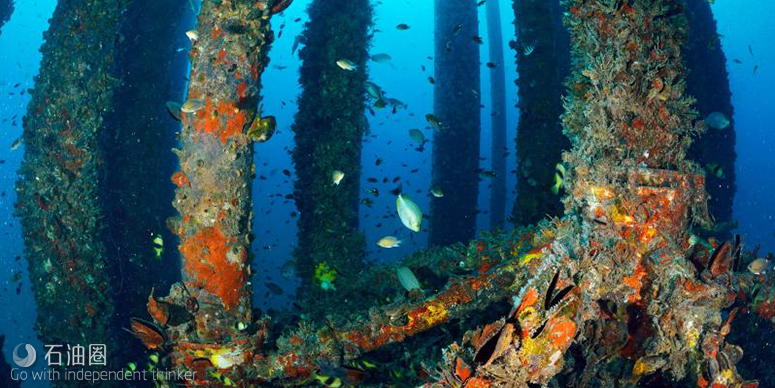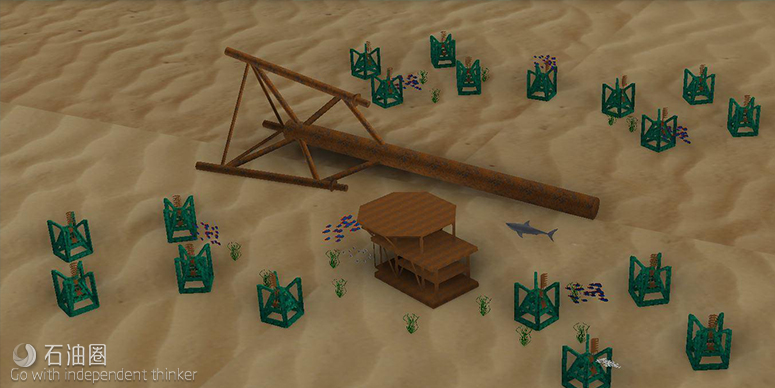Submerged structures of retired offshore installations have created effective and productive habitats for marine life
Fish stocks worldwide are under increasing stress due to raised levels of habitat degradation. State fisheries departments in many countries are undertaking habitat restoration projects to combat this phenomenon.
In conjunction, numerous offshore oil and gas installations, after many years of operation, are reaching the end of their productive lives, and the owners are required to decommission them in compliance with the rigorous decommissioning regulations that, as a base case, require removing everything from the seabed.
In the U.K. the international obligation on decommissioning is governed by the OSPAR Convention, which under the terms of Decision 98/3 prohibits leaving wholly or partly in situ the offshore installations. However, during their time in operation, which can last several decades, the submerged structures of these offshore installations have created effective and productive habitats for marine life, which would otherwise be destroyed once they were removed and taken out of service as requested by the rules.
Complete removal of offshore installations also has a significant impact on the decommissioning costs, which are estimated to be as high as tens of billions of dollars worldwide. The typical removal practice is to use a large crane vessel to lift the structure out of the water onto a barge after which it is then transported to a port, transferred ashore and scrapped.
This is a very expensive process that also poses significant safety and environmental challenges to operators and their contractors executing the decommissioning works.
In addition, the decommissioning activities are effectively subsidized by governments and local communities as the cost of removal is deemed to be a sunk cost, resulting in tax liability write-offs and reduced royalties to stakeholders.
The high cost is not the only issue when it comes to decommissioning old assets. Oil and gas operators’ reputations are at risk as certain cost-effective solutions may be perceived as shortcuts or attempts to pass liabilities onto taxpayers as well as causing environmental impacts that will affect future generations.
The cost factors are often used by operators to justify the “leave in situ” option. This is a decommissioning solution that is contemplated by industry regulators in some countries only when the operator has demonstrated, through extensive assessments, the adequacy of the site and structure. Other factors that are assessed include the future impact on the environment, whether disruptions to other users of the sea have been minimized, whether alternative options are feasible or too challenging and if a solution has been proposed with respect to the ownership and responsibility for future residual liabilities. Typically, a “sea-dumping permit” would then be lodged with the regulator, answering all the above questions and requiring approval from relevant government agencies.
Given that the decommissioning of redundant oil and gas assets affects many stakeholders, the solutions to all these challenges cannot be considered the dilemma of only the oil and gas operators or governments. A solution must be found collectively and with the cooperation of all the involved parties reaching a compromise that delivers value to all stakeholders, including the affected communities and the environment.
A new partnership between Xodus Group and Subcon International will deliver Integrated Rigs to Reef (IR2R) decommissioning solutions globally. The IR2R model offers a solution to the issue of the high cost of oil and gas asset decommissioning as well as reverses the reduction in fish habitats. The partnership combines Xodus’ decommissioning capabilities with Subcon’s extensive track record in the design and construction of purpose-built marine habitats.
IR2R versus the traditional R2R concept
Rigs-to-Reefs (R2R) is the practice of converting decommissioned offshore oil and gas facilities into artificial reefs.
R2R originally started in the U.S. as a nationwide program developed by the former Minerals Management Service (now the Bureau of Safety and Environmental Enforcement) of the U.S. Department of the Interior. The program has been popular with fishermen, the oil and gas industry and government regulators in the Gulf of Mexico with approximately 10% of decommissioned platforms being converted into reefs. However, this has not been the case on the West Coast of the U.S. where there has been significant opposition from environmental groups, especially in California. Similar opposition has prevented implementation of R2R programs in the North Sea.
While traditional R2R has a proven track record of delivering decommissioning cost savings and an effective fish habitat, it often leaves the question as to who is enduring liability for the retired structure. It also is not specifically designed to optimize the ecological benefit.
IR2R overcame these shortcomings by augmenting the obsolete oil and gas structures with purpose-built reef modules. The modules are installed around the platform structure on the seabed to enhance the new habitat and convert it into a more productive purpose-built artificial reef.
The integrated artificial reefs become a new asset whose ownership and liability can be transferred to the relevant government agency in charge of habitat restoration or to another stakeholder exploiting it for commercial purposes.
The IR2R concept provides an opportunity to turn the decommissioned structures into a new habitat construction project that is carried out with the involvement of all interested stakeholders in predetermined sites. It changes the conversation from a sea-dumping exercise (perceived only to be driven by cost reduction) to a habitat restoration project. Habitat restoration has broad community support as science, fishing, diving and environmental conservation communities all recognize that the earth’s seabed has been degraded and consequently fish stocks have plummeted.
The IR2R concept offers a solution to the issue of the high cost of oil and gas asset decommissioning as well as reverses the reduction in fish habitats. (Source: Xodus Group and Subcon International)
Oil and gas operators have an opportunity to actively invest in these new purpose-built enhanced reef structures and to be part of a project that has significant social relevance. This is not only because IR2R allows the reduction of decommissioning cost liabilities (whose burden is on taxpayers for approximately 30% to 40%) but also because distressed fishing industries can be reinvigorated by the increased fish numbers from reconstituted habitats.
The U.S. government as well as the governments of Malaysia and Indonesia, where fish is one of the most important sources of protein for the inhabitants, have understood the potential of these ideas and the enormity of the associated social return. These governments have placed R2R programs as a solution that must be considered when discussing the decommissioning of offshore oil and gas structures.
The IR2R model can provide a cost reduction for the decommissioning of offshore structures between 10% and 20%; however, reducing cost represents only one of the many benefits that the IR2R concept can provide.
IR2R can also significantly improve the marine environment to the benefit of recreational and commercial fishing industries (too frequently in distress in many areas of the world due to overfishing), improve tourism, benefit the local and international communities, reduce the environmental footprint of decommissioning projects and improve the reputation of oil and gas operators. It truly is a win-win for all stakeholders.

 石油圈
石油圈

